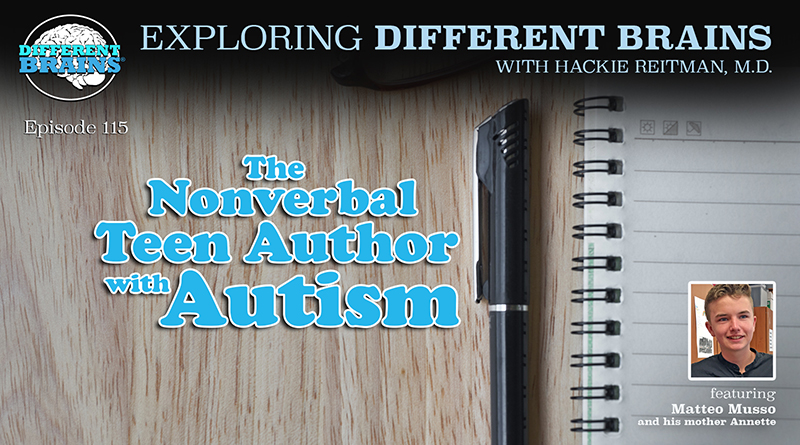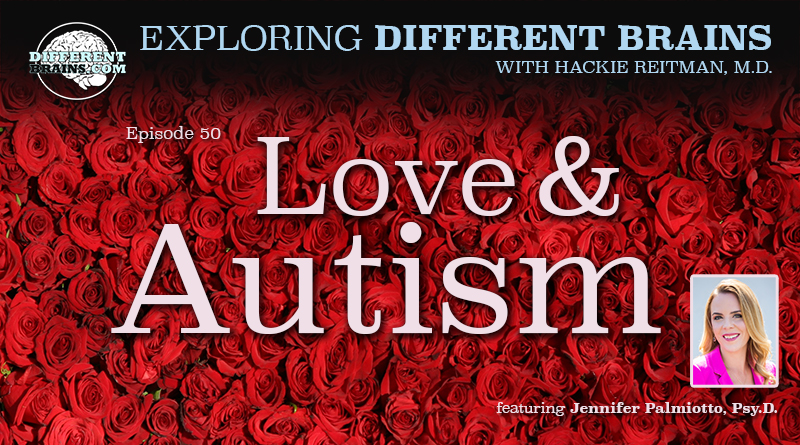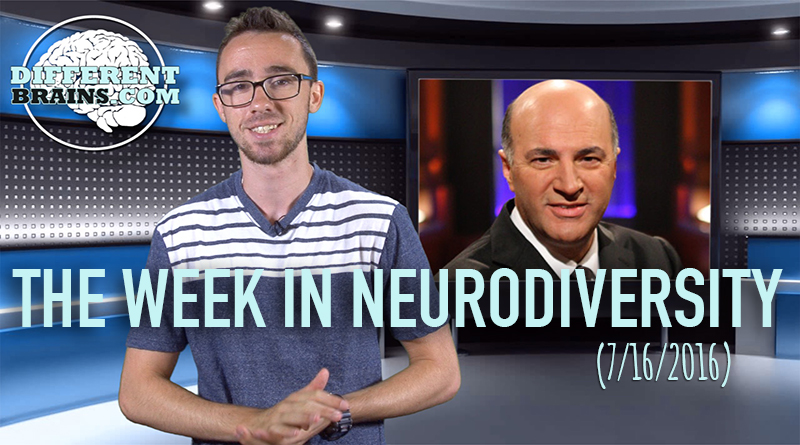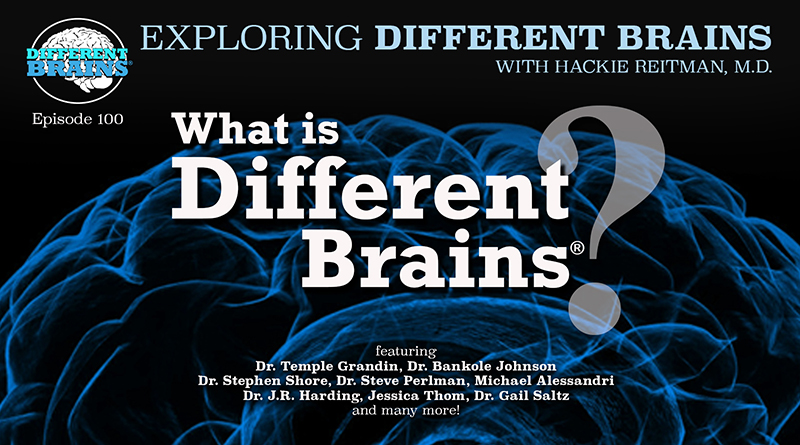
The Nonverbal Teen Author with Autism, with Matteo and Annette Musso | EDB 115
(26 mins) In this episode, Dr. Hackie Reitman speaks with Matteo and Annette Musso. Matteo is an author who also happens to be a nonverbal teen on the autism spectrum. He is joined by his mother Annette, which assists him with his communication. Matteo discusses what got him writing, and what he wants people to get from his story. Annette also discusses her support for Matteo, and her experiences as a mother to someone nonverbal.
For more about Matteo, his books, and his “Mondays with Matteo” video series, visit: http://matteomusso.com/
.
48 Second Preview:
.
To listen or download the podcast version of this episode, see the embedded player below.
Or look for us on your favorite podcast provider:
iTunes | Stitcher | SoundCloud
[expand title=”View Full Transcript”]
HACKIE REITMAN, M.D. (HR): Hi, I’m Dr. Hackie Reitman, welcome to another episode of Exploring Different Brains. Today we have Matteo Musso, whom I met along with his mother Annette out in Portland, Oregon when I was giving a keynote and on some panels at the United States Asperger’s and Autism Association meetings. Well, Matteo’s a bit of a star you see he doesn’t let the little things in life, like the fact that he’s nonverbal, stop him from being a writer, a poet, and a great communicator. He’s got a video that comes out, Mondays with Matteo, and he’s also got a book let me read the name of the book it’s called The Handbook of Us: Understanding and Accepting People With Autism. So Annette and Matteo, welcome great to see you guys again here at Different Brains
ANNETTE MUSSO (AM): Thank you. Great to see you too, Hackie.
HR: Annette, before we get started, why don’t you explain how Matteo, who’s nonverbal and writes beautifully, is going to communicate with us?
AM: Ok, he’s going to use a method called the rapid prompting method. You can see this is just an alphabet stenciled on this, um, clear piece of lucite, or whatever it is, plastic, and he will point one letter at a time, and I will sometimes say the letters out loud and then say the whole word back for you guys and then try to say the whole sentence at the end, and, umm, I just want to let you know, sometimes you’ll hear me saying “Move your hand,”, “Find it,”, “and, and, and”, and that is, umm, to compete with the stem in his brain that umm, uhh, that sometimes can be a little invasive and let him get off track so I’m just trying to keep him focused on the task at hand, which is to get his thought out through this means. So I’m not guiding him to any letters or anything, it’s just to, to keep him on task. Mmmkay?
HR: Matteo, why don’t you introduce yourself please to our audience?
MM: [Communicated through letter board] OK, I’m me and happy to be able to communicate with you verbal language lovers.
HR: Sounds good. Matteo, what made you first decide to start writing?
MM: [Communicated through letter board] I had twelve years of thoughts pent up in my head, so I asked Mom if she would help me write a book to express my thoughts and life experiences.
HR: The Handbook of Us: Understanding and Accepting People With Autism. What is the biggest message, Matteo, you want to get across to people in that book?
AM: Great question.
MM: [Communicated through letter board] I’d like society to remember to not judge a book by its cover, so to speak.
HR: Well, I think you have a very nice cover on your book.
MM: *laughs*[Communicated through letter board] I just know people associate intelligence and competence by outward displays of bodily actions. But often, the body does not show the intellect that’s in one’s mind.
HR: Having met you guys in person and some of his writing, his actual writing, explain to our audience about Matteo’s computer’s skills.
AM: We’re just learning how to type and that type of thing on the computer, but right now that’s not a means for him to express himself. It’s a means to learn how to physically type and move his fingers. So, there, uhh, he’s not putting anything into the computer, he dictates to me and I put things in the computer for him. So that’s going to come later as soon as he can communicate with this board laying flat and me not holding it.
HR: And how about handwriting?
AM: Handwriting we work on all the time, and, umm, again that’s the same thing. He can certainly tell me that sentence, that thought, and then write it out, word for word, after he uses this first, but to just sit and write out a thought without having this conduit, because that’s what this is serving as.
HR: So because I was observing him out in Portland and that was the sequence he went through and he was, he did, he did write that, so my way of thinking, not as a professional, but kind of common “sense-ically”, is the way Matteo’s brain is wired, once it gets registered in there through that letter board then it’s his to write out. Is that, Matteo, would you say that’s a correct way of thinking about it?
MM: [Communicated through letter board] That’s brilliantly said, Hackie. It helps me when I have a thought to spell it here first than to transfer it to anything else.
HR: Gotcha. Now, if it’s of interest to you guys, we interviewed a fellow named Shawn Smith from Canada who’s come down to visit us here. He was a football player up there and he- severe ADHD, saved all of his flunking grades from school and everything, couldn’t do math, couldn’t make change. When he and his wife went to Reno, Nevada and he became a blackjack dealer, when he picked up the different denominations, that registered with his brain, and he learned how to do math and how to make change and everything in a couple of days. So what I’m learning from all of this is that when our brains are wired a certain way, we find the pathways that can work best for our brains, and we all have some degree of neuroplasticity where the wiring in our brain can change through different extents, depending on the architecture we have to work with. So what we have here is we have a brilliant writer in Matteo and, uhh, if he’s trying to communicate it helps him first to spell it out and then to get the whole message out. It’s just a different wiring.
MM: [Communicated through letter board] It’s a confidence thing to have someone who believes in you close by.
AM: Technology is express. Technology can’t emotionally give him, umm, confidence or be his dance partner in this dance that we’re doing. It’s just a piece of equipment that isn’t that helpful and I think that is the biggest misunderstanding that people have, that they watch this and they go, “Why aren’t you using an iPad? Why aren’t you using a computer?” And, because they’re not human. They’re not human. And there is something to, umm, supporting each other as human beings, too, across, across this journey.
HR: Well, expanding upon that, when we have parents in our audience at Different Brains who might have a nonverbal child, what’s the biggest thing you guys might advise them?
AM: The biggest thing that I’ve learned on this journey, and it’s been so exciting and, umm, I’ve changed so much; I’ve always believed in him; I’ve always loved him of course as a human being, but I didn’t know what he knew. I kept telling myself, “I know he’s smart; I know he’s smart,” but I had no idea the depth of, of his, umm, his thoughts as a human being. It’s like living with, umm, the best philosophy teacher on the planet for me, and, umm, I think when we open our minds to the possibilities that our kids are so much more than they present us with physically and their ability to show us their intelligence through traditional education or a testing method that are so imposed on our kids, once we just kind of forget about all that and go, “I know. I know he’s intelligent; I know he understands; I know I should be reading, we should be reading books together at an age appropriate level instead of the Dr. Seuss books he goes and grabs all the time because that’s his habit; that’s his stem; that’s his OCD, whatever. Once we get past that, the whole relationship changes because the, the child or autistic person, and it doesn’t matter the age, feels this mutual respect back and forth and bam, that changes. And so anyone can start doing that, right now, this very minute. Just decide that your child understands. What’s it hurt? It hurts them a lot more when we assume they don’t understand until they can prove it to us in a way that we can see it. They’re telling us stuff all the time. We’re just not seeing it. We’re just not seeing it.
HR: Well, we have to, uhh, we have to seek more to connect than we do. Now, Matteo, it says on your website, and I’m quoting here: “Autism is not a neurological condition, but a spiritual energy.” Tell us about that.
MM: [Communicated through letter board] Well, one of my most fun and pertinent sayings is, “I am autistic for so many reasons, but one of the biggest is to open the minds of society and help us all reexamine our priorities.”
HR: Very well said.
MM: [Communicated through letter board] Spiritual journey is not necessarily any particular religion but rather an internal growth and why are we here sort of thing. Autistics open a new understanding of life for so many people who want to learn. That’s definitely not everyone.
HR: So Nat and Matteo, if people want to find out more about you, how do they find you? How do they find you online?
AM: Perfect. Uhh, yeah, thank you. They go to, uhh, matteomusso.com and everything’s linked up there, umm, his Mondays at Matteo segments, uhh, you can, uhh, subscribe and just be notified, uhh, when they get posted, and we’re getting them cut down from 20 minutes to about five or seven minutes so that’s, that’s good. Umm, ahem, his, his blog, Pedaling with Teo is there, where we put his poetry and his, well, I think it’s just under poetry and all the different things he’s writing. He’s doing a restaurant reviews, now, he’s, uhh, called Teo’s Tasty Adventures for Jer-… very entertaining to read about, uhh, how he appreciates water when he drinks it at a restaurant, or a, a smoothie, and you know we don’t really take the time necessarily to think about that glass of water in a way that, that he notices. How good it is and how it feels in his body, it’s, it’s just kind of fun, you know. So, uhh, and they can keep up to date with the talks he’s been invited to do, and stuff.
HR: Well, it’s been great to see you guys again, great to have you here on Exploring Different Brains, and we want to wish all the best of luck and stay in touch. Matteo, you’re the best; keep up the good work.
MM: [Communicated through letter board] Thanks, cool Hackie. I like chatting with you.
HR: I like chatting with you too. Great to see you guys and we’ll see you again soon. Thanks for being with us here at Different Brains.
AM: All right, have a great day.
MM: Bye bye!
[/expand]
.
Different Brains® Inc. founder Harold “Hackie” Reitman, M.D. is an author, filmmaker, retired orthopedic surgeon, former professional heavyweight boxer, the past chairman and president (and current board member) of The Boys and Girls Clubs of Broward County, and a neurodiversity advocate. However, it was his role as a father that led to the creation of the DifferentBrains.org website.
Hackie’s daughter Rebecca grew up with epilepsy, 23 vascular brains tumors, and underwent 2 brain surgeries before the age of 5. Her struggles and recovery put him on the road to, through 26 professional heavyweight boxing matches, raising money for children’s charities (to which he donated every fight purse).
Rebecca eventually went on to graduate from Georgia Tech with a degree in Discrete Mathematics, and Dr. Reitman wrote and produced a film based on her experiences there (The Square Root of 2, starring Darby Stanchfield of ABC’s Scandal). After graduation, Rebecca received a diagnosis of Asperger’s syndrome. Hackie, shocked at his own ignorance of the topic despite being an M.D., embarked on years of research that culminated with his book Aspertools: The Practical Guide for Understanding and Embracing Asperger’s, Autism Spectrum Disorders, and Neurodiversity (released by HCI books, publishers of the Chicken Soup for the Soul series).
This experience revealed to Hackie the interconnectedness of the conditions that fall under the neurodiversity umbrella, while alerting him to the in-fighting and fractured relations that often plague the organizations tasked with serving the community. Convinced that overcoming these schisms could help all of society, Hackie forged the Different Brains philosophy of inclusive advocacy: “Supporting Neurodiversity – From Autism to Alzheimer’s and All Brains In Between”.
In the company’s initial years of operation, Hackie self-financed all of the content on DifferentBrains.org, all of which offered free to view to the public. Currently he is the host of our weekly interview show Exploring Different Brains, writes blogs for the site, and tours the country speaking at conferences, conventions and private functions, all with the goal of improving the lives of neurodiverse individuals and their families, and maximizing the potential of those with different brains. Separate from Different Brains, Hackie is the founder and CEO of PCE Media, a media production company focusing on reality based content. He recently co-executive produced the documentary “Foreman”, the definitive feature documentary on legendary boxer and pitchman George Foreman.




